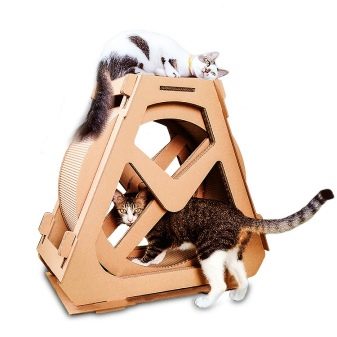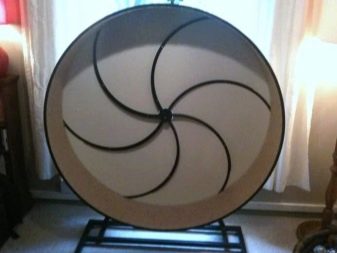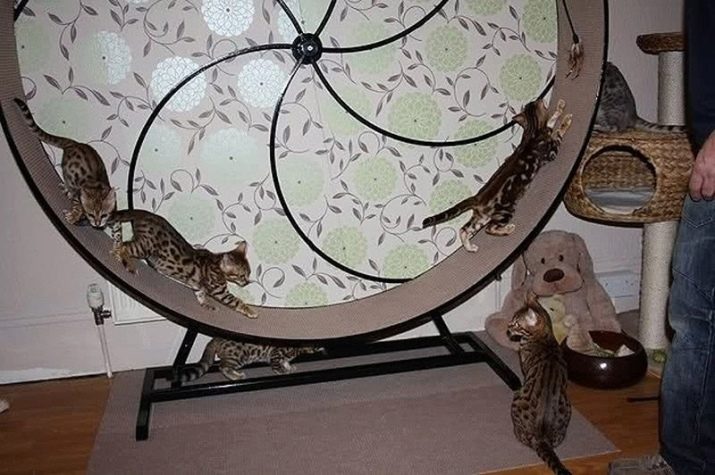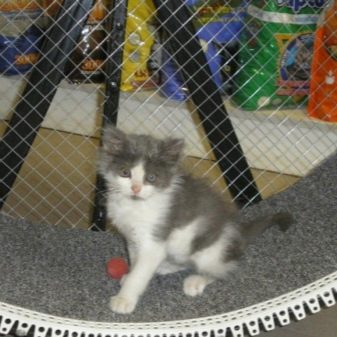Treadmills for cats: selection and training

All cats are predators by nature and need active movement. However, domesticated pets can have different temperaments depending on the breed and character. Passive individuals prefer to spend most of their time alone. Active cats are often on the move and for them there are special running wheels. The subtleties of choosing and accustoming a pet to a simulator will be discussed in more detail in this article.


Who needs it?
The treadmill is a kind of trainer, which is primarily needed by active domestic cats. The space in the apartments is rather limited and the animals do not have the opportunity to throw out all their energy. If you prevent an active pet from playing, then over time it can become lazy and spend most of its time sleeping or by the bowl of food.
Passive individuals increase the risk of gaining excess weight, which, in turn, can lead to serious health problems. The jogging wheel will be an excellent alternative to free-range outdoor activities for natural predators.
Among all cats, representatives of the following breeds are active:
- abyssinian;
- Somali;
- Egyptian Mau;
- savannah;
- bengal;
- oriental;
- siamese;
- Ocicat.
However, this does not mean that only these animals will like the simulator. Any cat can be active, regardless of its belonging to any breed.

Advantages and disadvantages
Cat treadmills have both advantages and disadvantages. Let's consider the advantages of such a simulator.
- The wheel allows you to organize your pet's leisure time. Individuals who like to run around the apartment in the morning and at night will no longer bother tired owners and wake them up.
- The health benefits of cats are undeniable. For lazy individuals, occasional jogging helps to maintain normal weight and not get fat. Active pets will be able to throw out their energy at any time. Exercise also helps maintain muscle tone.
- Treadmill exercise allow not only to maintain normal weight and train muscles, but also have a beneficial effect on the cardiovascular system and lungs.
- Many wheel models the inside is lined with carpet and can serve as a scratching post for your pet.


As for the shortcomings, they are not so significant for running wheels. Let's highlight the main disadvantages of the simulator.
- Ready-made models are quite expensive.... However, on the Internet you can find ready-made drawings and instructions for the manufacture of such wheels, which will save money.
- Some simulators are quite oversized. and are only suitable for large rooms.
- Not all cats are ready to immediately appreciate all the advantages of a treadmill. The owner sometimes has to spend a lot of time to train the pet to the trainer.
Jogging wheels are not suitable for all cats. And it's not always about the temperament of the animal. If the cat has any injuries or diseases, training on the simulator may be unacceptable.


Varieties
All treadmills work the same way. Ready-made models of trainers for cats in the first place differ in size, material of manufacture and appearance.
Wheels can be of different diameters: small designs are designed only for kittens, and therefore after the animal grows up, they will become unnecessary. Larger machines are more practical and will be very useful, especially if several cats live in the house.
As for the materials, they can be very different. Most often used wood, plastic and metal. Simple kitten models can also be made from cardboard... The most versatile option in this case is wood.
Let's consider these options.
- Wood is originally an environmentally friendly material and will not cause allergies in the animal or other inhabitants of the house. Usually exercise machines made of wood are quite light and can easily be moved to a new place. Also, wooden models will fit well in almost any interior.


- Plastic wheels have small weight and dimensions. However, such designs cannot be called reliable and durable. They are quite unstable, and if any part of the simulator breaks down, it will be extremely problematic to replace it.


- Metal models are the most difficult, but at the same time they are stable and reliable. Moving the structure to a new location will be a little problematic. But the likelihood that the wheel will quickly fail is extremely small. Typically, such models are made to order or independently, if you have experience with welding equipment.


- Cardboard wheels can hardly be called a full-fledged simulator. These models are designed exclusively for kittens and small breeds of cats. It is highly likely that animals will use the product for other purposes and, instead of training, will prefer to tear off pieces of cardboard from it.

Several materials can be used for manufacturing at once. At home, you can make a wheel of the desired size and characteristics.
As for the design, then distinguish between open and semi-closed types of wheels. In open models, the wheel has no side walls. Semi-closed options involve one partition. Open trainers rotate due to rollers that are attached to a stand located under the wheel. In closed models, the rotation mechanism is located on the side, therefore, such simulators are considered more stable.


How to choose?
When choosing a running wheel, first of all, you need to take into account the amount of free space in the apartment, which can be allocated for the installation of the simulator. You also need to take into account the number of cats in the house, their height and weight. For a large number of animals or for a large pet, massive, stable semi-closed models are best suited.
Veterinarians recommend against using wheels less than one meter in diameter. In this case, the width of the track should not be less than thirty centimeters. Otherwise, the animal may injure the spine while exercising on small simulators.
When purchasing a finished model in a store, you must carefully examine the entire structure. A product made of low-quality materials or with poor fasteners can, at best, not last long, and at worst, cause injury to a pet.
The inner surface of the wheel must not be slippery. It is best if it is covered with carpet or felt. Exercise machines differ in appearance and can be of different colors, so you can choose the right option for any interior.

How to do it yourself?
Cat running wheels are just beginning to gain popularity in Russia. The prices for such simulators are quite high, and it is not always possible to find a product in a small town. You can, of course, order a wheel in an online store, but then it will not be possible to pre-inspect it for defects and you will have to trust the seller's word or the description on the site.

If you have the necessary materials and tools, you can make the simulator yourself. It doesn't take long and doesn't cost much. The easiest way is to make a wooden wheel. To make it, you will need the following materials and tools:
- sander for wood;
- thick sheets of plywood;
- carpet or felt;
- tape measure and rope;
- construction pencil;
- bolts and nuts;
- Miter saw;
- small wheels;
- construction glue;
- wooden slats and beams;
- fasteners;
- knife and drill;
- bearings.
First of all, on the sheets of plywood, it is necessary to outline the boundaries of two circles, which will serve as a frame for the future simulator. It is desirable that the diameter of each is at least one meter. Next, you need to cut out two circles and fasten them together at a distance of at least thirty centimeters using bars.


The bars, in turn, are fastened to the plywood using a screwdriver, glue or ordinary nails. The empty cavity between the circles must be closed and this is done by gluing the strips around the circumference of the wheel. To make the structure stronger, the slats are pulled over with a dense rope or belt.


When all the elements of the wheel are glued to each other, you will need to cut out one or two sides, depending on the type of future design. Next, you need to make a stand with wheels and attach it either to the side wall of the drum, or directly below it.


To make the stand, you will need two small pieces of plywood in the shape of a semicircle. A pair of rollers is installed on both sides, which will rotate the structure. For a semi-closed structure, it is necessary to make a special axle for rotation and attach it to the side wall of the wheel.


The finished wooden structure must be coated with a special compound that prevents wood from rotting. The inner surface must be finished with felt or carpet. You can attach pieces of cloth to double-sided tape, but it will be safer to use glue.


How to train an animal to use the simulator?
Many cats are distinguished not only by their activity, but also by their innate curiosity. These pets are happy to research new items on their own. In this case additional training in working on the simulator will most likely not be required, and the cat will master the wheel on its own.
However, not all domestic cats will be ready to take the initiative in learning the treadmill and will be reluctant to learn something new. In any case, before starting any action and trying to seat the pet in the wheel, you need to give him some time to get used to the simulator. Let the animal independently approach the object, inspect and sniff it.
To draw attention to the wheel, you can put your favorite cat toys next to it or directly in it. You can lure your pet to the simulator using a laser toy. In order for the animal to take a few steps inside the drum on its own, you can fix a toy on the side surface.


After the first movements in the wheel, the cat can get scared and run away. In no case should you scold your pet for this. Usually within a week the cat gets used to the trainer and willingly starts using it. You should not expect and demand from the animal that it runs in the wheel for a long time, since cats have nothing to do with hamsters or squirrels.
For information on how to make a cardboard running wheel for cats, see below.
































